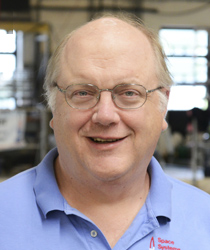Facilities
A leader in the area of astronautics, the Space Systems Laboratory is centered around the Neutral Buoyancy Research Facility, a 50-foot diameter, 25-foot deep water tank that is used to simulate the microgravity environment of space. The only such facility housed at a university, Maryland's neutral buoyancy tank is used for undergraduate and graduate research at the Space Systems Lab.
Research focus
Research in Space Systems emphasizes space robotics, human factors, applications of artificial intelligence and the underlying fundamentals of space simulation. There are currently five robots being tested, including Ranger, a four-armed satellite repair robot, and SCAMP, a 6 degree of freedom free-flying underwater camera platform. Launched by NASA in 1996, Ranger and its predecessor robot were both constructed in the Space Systems Lab.
Current projects include the MX-2 suit, a simplified neutral buoyancy spacesuit for use in EVA research; Power Glove, a prototype motorized spacesuit glove which will help reduce astronaut hand fatigue; and TSUNAMI, an apparatus to test human neuromuscular adaptation in different gravitational fields and different simulations of weightlessness.
History
The Space Systems Lab was founded at MIT in 1976, by faculty members Renee Miller and J.W. Mar. Its early studies in space construction techniques led to the EASE (Experimental Assembly of Structures in EVA) flight experiment which flew on Space Shuttle mission STS-61-B in 1985. In 1990, lab director Dr. Dave Akin moved the lab to the University of Maryland. The Neutral Buoyancy Research Facility, or NBRF, was completed in 1992.

|
David AkinProfessor301-405-1138 | dakin@ssl.umd.edu Profile |
Top